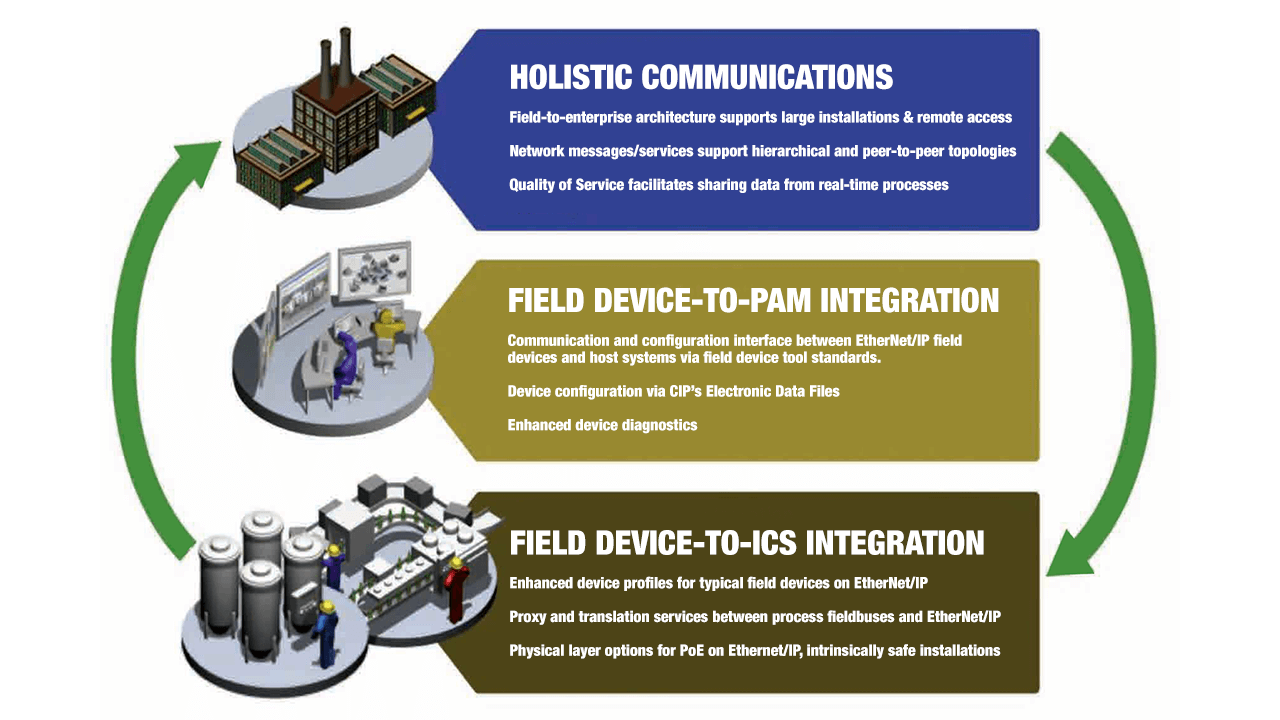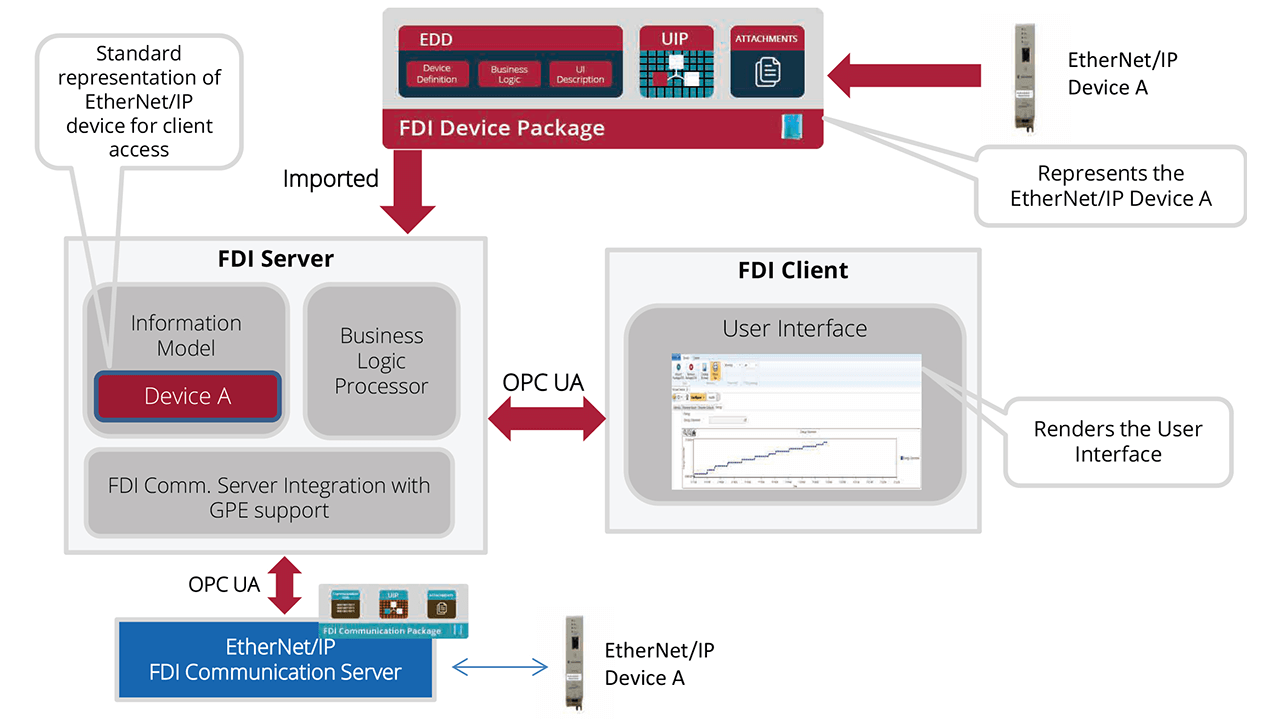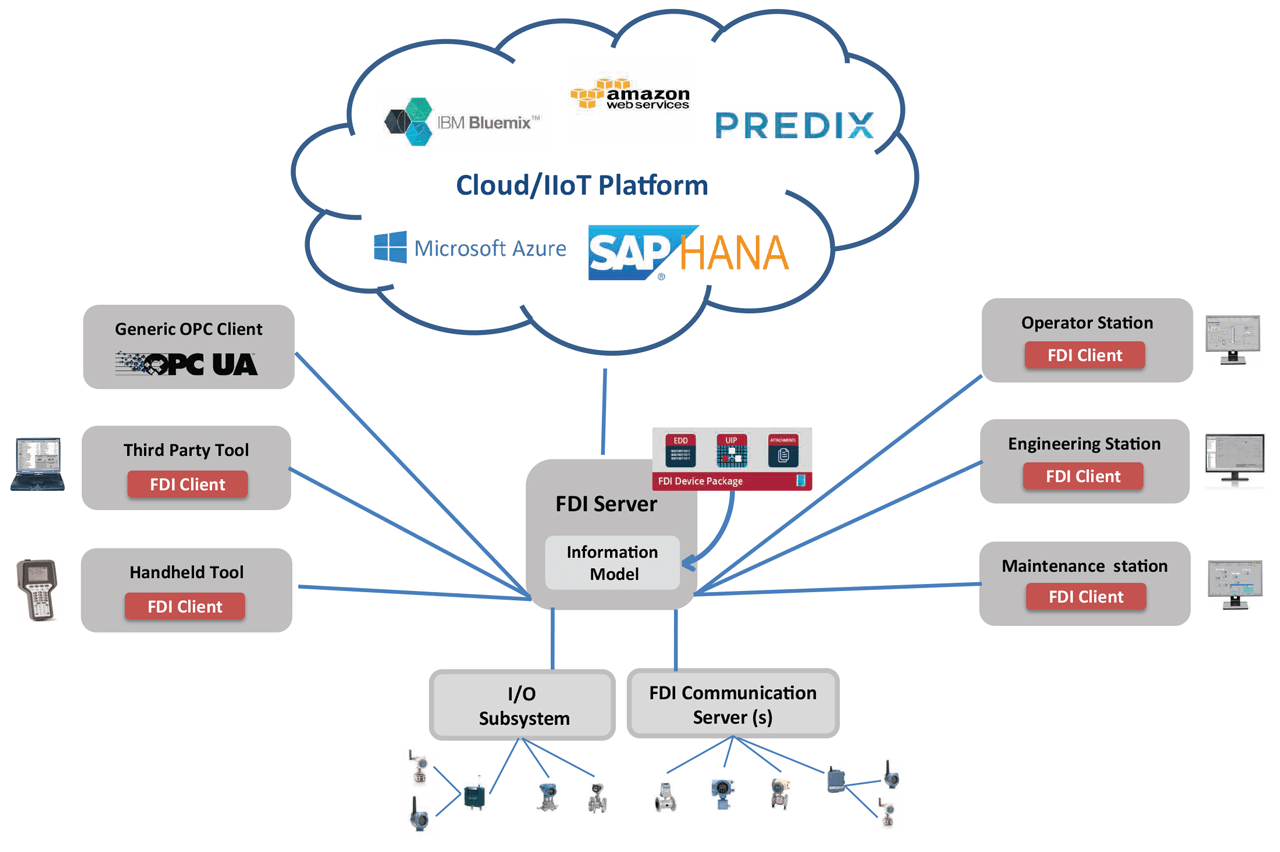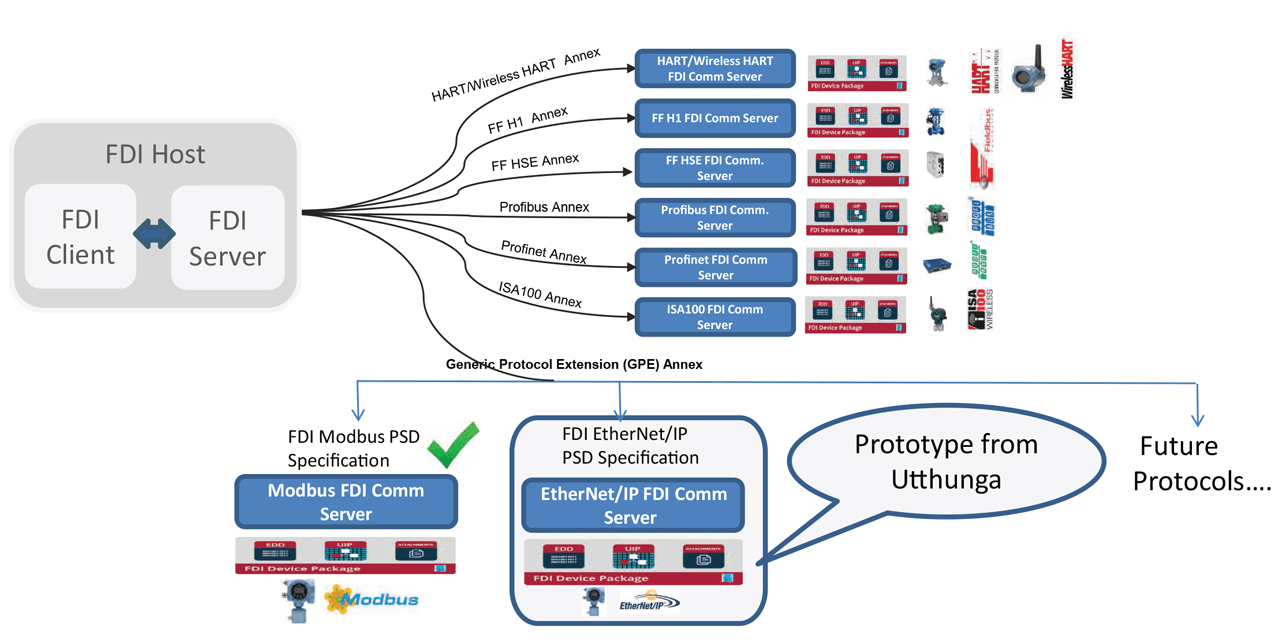ApplicationsNovember 28, 2018
EtherNet/IP & FDI creating value for process automation

The optimization of process integration initiative (OPI) is continuing to develop. FDI device packages required for Field Device Integration (FDI) are emerging. The result is that the EtherNet/IP protocol and FDI Device Integration standard is going to play ongoing, emerging role in the process automation industries.
The NAMUR position paper, “An Ethernet communication system for the process industry”, calls for protocols including IEC 61784-2 CPF2/2 (EtherNet/IP) and IEC 61784-2 CPF3/5 (PROFINET IO CC B) to become minimum binding requirements for the process industry.
NAMUR also recommends FDI device packages required for Field Device Integration (FDI) shall be available in the devices and capable of being transmitted to central tools. The result is that the EtherNet/IP protocol and FDI Device Integration standard is going to play vital role in the process automation industries in the near future.
OPC UA is an interoperability standard for secure and reliable information exchange widely adopted in the industrial automation. FieldComm Group has collaborated with OPC Foundation to create the FDI Information Model which provides the harmonized protocol agnostic data to the enterprise layer.
EtherNet/IP device supporting FDI technology can be made available via FDI Information model to manufacturing execution systems (MES), and enterprise applications such as Enterprise Resource Planning (ERP) and Supply Chain Management (SCM).
This article describes research and prototype done on supporting the EtherNet/IP protocol in Device Integration Standard FDI and how it benefits EtherNet/IP device suppliers, Automation host suppliers as well as ODVA and FieldComm Group community in achieving their objective towards providing optimized solution in Process Industries.

FDI Server is responsible for communicating with underlying EtherNet/IP device network via EtherNet/IP FDI Communication Server using standard OPC UA interfaces.
Optimization of Process Integration
With its strong installation base and user experience in Hybrid and Discrete Industry, ODVA vision is to proliferate adoption of EtherNet/IP in the process industries with its new initiative OPI(Optimization of Process Integration) which defines a strategic vision for manufacturers looking to maintain cost-effective, sustainable production capacity in the process industries.
The approach will simplify exchange of configuration, diagnostic and production data between field devices and higher-level systems such as supervisory control and data acquisition systems (SCADA), plant asset management (PAM). Secure remote access of field installation will be enabled and plant to
enterprise communication simplified. ODVA envisions an approach to the optimization of process integration that is convergent, compatible, scalable, and open for users and their suppliers.
ODVA has identified three primary use cases for optimization of process integration. Field Device to ICS Integration: This use case is the foundation of OPI. It envisions the integration of all existing installed process Fieldbus into EtherNet/IP system and communication improvements like enhanced diagnostics and instrumentation data on Industrial EtherNet.
It also includes physical layer options such as Power-over-Ethernet and confirming to the emerging standards for intrinsically safe. Field Device to PAM Integration: This use case is the accelerant for OPI. It envisions that in all stages of field device life cycle from commissioning and operation to calibration and maintenance, it provides optimal performance which is very crucial for the Process Automation Industries where installations are expected to operate for long periods without shutdown.
Holistic field-to-Enterprise Communication Architecture: This use case is the integrator for OPI. It envisions a single, converged and transparent enterprise-wide communication architecture which can provide full access between the automation and enterprise resource planning that allows virtually unlimited access to data anywhere, any time. OPI will allow users to update and improve the performance and serviceability of field installations as well the integration of process applications with the overall enterprise in a safe and secure manner.
Role in OPI
One of the primary three use cases of OPI is Field Device to PAM Integration which envisions simplifying the exchange of configuration, diagnostic and process data between field devices and higher level systems that must be standardized, usable across all systems, and independent of device suppliers, system suppliers, or vendor-specific tools.
Existing Device Integration Standard EDDL (Electronic Device Description Language): EDDL is an international, IEC-61804 standard for Device Integration. Since 1992, EDDL is the most widely used Device Integration Standard in Process Industries.
EDDL is used in the Intelligent Device Management (IDM) software part of major process control systems and in portable maintenance tool to support device diagnostics, configuration, calibration, and access to internal variables of the device.EDDL is descriptive language and Operating System independent. EDDL can be supported in various platforms like Linux, Windows, Android, etc. EDDL files are imported, not installed hence it does not affect the runtime stability of the DCS system. However, EDDL influences the presentation in the host system and has limitation in representing the complex device functionalities.
Supported Communication Protocols: HART, Wireless HART, PROFIBUS, PROFINET, Foundation Fieldbus and ISA100 Wireless.
An EDDL file basically includes the definition for the following information. Device Identification: Every DD file is identified using Device Identification information and it contains MANUFACTURER Code, Device Type Code, Device Revision and DD revision.
Data Description: The data definition describes how the data can be accessed by EDD applications from the device using EDDL constructs like VARIABLE, ARRAY, BLOCK, LIST etc. A VARIABLE construct is the principle mechanism for modeling the data items found in the device. Sample VARIABLE construct for temperature unit along with condition based enumeration list is shown. The VARIABLE definition shows that, Temperature unit ‘degC’ is not available when sensor type value (trans_ sensor_type) is ‘LINEAR’.
User Interface Description: EDD applications can be characterized as either PC application or a handheld application. Menus, Graphs, & Charts are the few of the item types widely used in User Interface. Sample Menu definition with various styles is shown below. Based on the style definition in the MENU EDDL construct, User Interface differs. A CHART construct is used to graphically display the dynamic variables. The CHART TYPE can be either a Gauge, Horizontal Bar, Vertical Bar, Sweep or Strip.
COMMUNICATION Description: Communication definition is protocol dependent and is defined using various attributes within COMMAND definitions in the EDDL File.
METHOD Description: METHODs are represented as wizards. Some of the device functionalities like Device Setup, Trim, Calibration, etc. will be implemented as Methods in the EDDL file.

Cloud architecture of FDI system.
FDT (Field Device Tool)
FDT is an international, IEC-62453 open standard for industrial automation integration of networks and devices, harnessing IIoT and Industrie 4.0 for enterprise-wide connectivity. The technology enables configuration, operation and maintenance through a single, standardized user interface, regardless of supplier, device type/function or communication protocol.
Most major system manufacturers today integrate the FDT Technology in their product/ solution offerings and more than 8,000 devices currently employ this technology. Unlike EDDL, FDT is a software component and can offer rich graphical user interface with no limitation to depict complex device functionalities. The FDT specification v1.2x depends on Microsoft COM and ActiveX technology and FDT v2.0 is based on Microsoft .Net technology, hence FDT v1.2x and v2.0 supports only Windows Operating System. FDT Group upcoming FDT IIoT Server based architecture (FITS) supports other platforms as well.
Supported Communication Protocols: Sixteen communication protocols have been supported by the FDT standard including CANOpen, CC-Link, CompoNet, ControlNet, DeviceNet, EtherNet/IP, EtherCAT, Foundation Fieldbus, HART, Interbus, IO-Link, Modbus, ISA100 Wireless, PROFIBUS, PROFINET and SERCOS.
FDI (Field Device Integration)
FDI is an international, IEC-62769 standard for Device Integration and Device Management Technology, combining base concepts and technology aspects of the Electronic Device Description Language (EDDL) according to IEC 61804 and Field Device Tool (FDT) according to IEC 62453, as well as in IEC 62541 1 (OPC UA).
Supported Communication Protocols: HART, Wireless HART, PROFIBUS, PROFINET, Foundation Fieldbus, ISA100 Wireless, Modbus and Generic protocol.
FDI basically consists of two elements. The core of FDI is the FDI Device Package, which are then imported into the FDI Host Systems.
FDI Device Package
The FDI Device Package offers all the elements necessary to integrate field devices into the host. It consists of EDD and an optional UIP (User Interface Plug-in) and an attachments. EDD file consists of Device Definition, User Interface Descriptions, and Business Logic associated with the field device.
UIP (User Interface Plugin) is the programmed user interface (software component) which offers the flexibility to represent complex device functionalities. Wiring diagrams, registration certificates, and user manuals can be added to the FDI Device Package as attachments. All these elements are digitally signed in the secure FDI Device Package.
FDI Host System
FDI Device Packages are imported into the FDI host system. FDI Host systems consist of FDI Client and FDI Server. EDD Engine component within the FDI Server interprets the EDD element within the FDI Device Package and builds the FDI Information Model (OPC UA) which will be exposed to the FDI Client.
FDI Client is responsible for rendering the user Interface defined in the EDD file and also the UIPs. FDI Server can have the native communication driver or use the FDI Communication Server to communicate with underlying field devices.
Device Integration Standards
EtherNet/IP has been supported by the FDT Standard. By supporting FDI also as the standard communication and configuration interface between the field devices supporting EtherNet/IP and host system will proliferate the ODVA’s Field Device to PAM Integration use case.
Technical Aspects of supporting EtherNet/IP in FDI: This section covers the technical details on supporting the EtherNet/IP device in FDI host system using the Generic Protocol Extension.
Generic Protocol Extension
FDI is built with vision of being one device integration standard for all devices of process Industry, independent of communication and manufacturer.
The FDI specification contains Annex document to support specific protocols like HART, WirelessHART, Foundation Fieldbus, PROFIBUS, PROFINET, ISA100 wireless networks and other standard and/or proprietary communication.
The FDI Generic Protocol Extension (GPE) specification has been developed with the vision of adding support for more protocols including proprietary without changing host implementation. Any protocol including proprietary protocol can be supported using GPE specification along with Protocol Specific Definition (PSD).
PSD specification document contains the protocol specific information and needs to be specified per protocol so that FDI Communication Servers and FDI Device Packages supporting the protocol can work together in a host which is not aware of this specific protocol itself.
Modbus support in FDI
Modbus communication protocol has been supported and verified in FDI. FDI Host with support for FDI Communication Server with Generic Protocol Extension will be capable of supporting any communication protocol. This has enabled any Modbus device to be supported in FDI Host using Modbus Device Packages and Modbus FDI Communication Server/Package.
EtherNet/IP support in FDI
To support EtherNet/IP Device in FDI, it requires:
- FDI Host to support Generic Protocol Extension
- EtherNet/IP FDI Communication Server
- EtherNet/IP FDI Device Package for EtherNet/IP field device
Generic Protocol Extension support
FDI Host can have native communication drivers or integrate the FDI Communication Server to support various communication networks in the plant.
FDI Host with support for Generic Protocol Extension can support any protocol by integrating the specific FDI Communication into the host Server and device package without changing the host implementation.
FDI Communication Server
EtherNet/IP FDI Communication Server is a dedicated OPC UA Server which hosts the FDI Communication Server Information model and EtherNet/IP driver. EtherNet/IP driver communicates with the underlying network and provides the information to the FDI Communication Server Information model.
The FDI Communication Server Information model reflects the communication networks including their properties, relationships and operations that can be performed on them.
Configuring Communication Server
In the information model, ParameterSet in the CommunicationServerType contains all the necessary parameters like IP Address, Port, etc. to configure the FDI Communication Server and this information will be fetched from the EtherNet/IP FDI Communication Package associated with the EtherNet/IP FDI Communication Server.
These parameter settings are used during Initialize operation to initialize the underlying network. EtherNet/IP FDI Communication Package is used along with FDI Communication Server to validate and configure the communication channel parameters.
FDI Communication Package
EtherNet/IP Communication Package shall contain the Communication EDD as per the service parameters in the Connection Manager Object Specific service Forward_Open.
Some possible parameters are defined below.
- IP Address (MAC Address)
- Port
- Connection Size with option for Fixed/Variable
- Priority with possible values of Low, High, Scheduled, Urgent
- Connection Type with possible values of Null, Multicast, Point2Point, Reserved.
Scan & Rescan EtherNet/IP Devices
In the information model, Scan operation from FDI Server will trigger the Scan operation available in the ServerCommunicationDeviceType and returns the list of devices as specified in the protocol specific profile of FDI specification.
In case of an EtherNet/IP, Scan Method in the FDI Communication Server Information model sends the ListIdentity request to the underlying network. Response received for ListIdentity request will be mapped to the TopologyScanResult schema used in the Scan method. List Identity response includes some of the attributes of the Identity Object (Class Code 01 Hex). TopologyScanResult schema is defined in the Generic Protocol Extension specification of FDI Annex document.
Device I/O operation
Any Read/Write operation from FDI Server shall trigger the Transfer operation on the ServerCommunicationServiceProvider in the FDI Communication Server Information model.
Header attribute defined within the Command construct of FDI Device Package includes the necessary information like Class ID, Instance ID and Attribute ID to perform read/write Operation.
For Transfer method in the FDI Communication Server Information Model, EtherNet/IP driver shall use the SendRRData command within the EtherNet/IP specification to perform Read/write operation on the EtherNet/IP device.
It is also possible to use the Class 0/1 connection in the EtherNet/IP to perform cyclic I/O Data exchange operation and it shall be mapped to GetPublishedData method in the above FDI Communication Server Information model.
EtherNet/IP FDI Device Package
EtherNet/IP FDI Device Package represents the EtherNet/IP Device and shall be provided by the EtherNet/IP device vendors. It provides all the elements necessary to integrate EtherNet/ IP device to the Automation Host systems.
Sample EtherNet/IP FDI Device Package: Sample EtherNet/IP FDI Device Package shall be developed as per the Generic Profile Extension of the FDI Specification.
EtherNet/IP EDS file in FDI Host system: Existing EtherNet/IP devices in the marketplace have an associated EDS file which contains configuration details relevant to EtherNet/IP device. These EDS files can be used in the FDI technology in two ways.
EDS file as an attachment in FDI Device Package: Existing EDS file associated with EtherNet/IP device can be added as an attachment in FDI Device Package. FDI Host which supports EDS parser can use this information associated with the FDI Device Package.
EDS file to FDI Device Package conversion: Existing EDS file can be converted manually or using tool to create the EtherNet/IP EDD file packaged as FDI Device Package. In this case, it is not necessary for the FDI host to support EDS Parser.
EtherNet/IP protocol workflow
FDI Device Packages for EtherNet/IP device are imported into the FDI Host system. The Device definition and Business Logic are used exclusively by an FDI Server and the User Interface Description (UID) is processed by the FDI Server and transferred to the FDI Client. Each EtherNet/IP Device package instance is represented in the FDI Server Information model and provide an access to the FDI Client.
FDI Server is responsible for communicating with underlying EtherNet/IP device network via EtherNet/IP FDI Communication Server using standard OPC UA interfaces. Any read/ write and subscription operation invoked on EtherNet/IP device will be passed to the FDI Server which in turn passes it to the EtherNet/ IP FDI Communication Server and passes the processed result back to the FDI Client.
FDI Client is responsible for rendering the User Interface both for UID (User Interface Description) which will be provided in EDD file of EtherNet/IP Device Package and an UIP. FDI Server provides FDI Client an access to information about Device Instances (FDI Information model) which is driven largely by the EtherNet/IP Device Definition file in FDI Packages.
This information can be provided via OPC UA services.
FDI Information Model
The FDI Information model (IEC62769-5) is a companion standard to the OPCUA for Devices (IEC62541-100) specification which is an extension to the OPC Unified Architecture specification series.
OPC UA for devices defines the information model associated with field Devices in below three models which builds upon each other.
- Device Model
- Device Communication Model
- Device Integration Host Model
FDI Information Model reflects the topology of the automation system and represents the devices of the automation system, connecting communication networks including their properties, relationships, and the operations that can be performed on them.
Cloud integration using FDI
FDI Technology can be used as platform for providing the harmonized data to the higher level systems. It standardizes and harmonizes the wealth of information provided by underlying various Industrial network. This enables any FDI compliant OPC UA client to harvest the data from the FDI host in a standardized way and provides the plant level to enterprise wide connectivity.
FDI Server hosts the FDI Information Model exposing the underlying device network. FDI Server can choose to have either native communication driver or FDI Communication Server for supporting underlying device network. Device instance of the loaded FDI Device Package associated with the field device will be exposed in the FDI Information Model, Engineering Station, Maintenance Station, Operator Station or handheld configuration tool can have FDI client communicating with the FDI OPC UA Server over OPC UA communication channel.
Generic or any third party client application can also connect to FDI OPC UA Server. FDI OPC UA Server can also provide the connectivity to the cloud platform for further processing to support various IIoT use cases like remote data monitoring, predictive maintenance etc.

Illustration shows various Industrial Communication profiles supported by FDI specification. HART/Wireless HART, FF H1 and HSE, Profibus, Profinet, ISA100 using respective FDI Communication profile specification. Generic Protocol Extension specification allows support of future protocols.
Value proposition
End Users: Most of the FDI requirements are driven by NAMUR, the “User Association of Automation Technology in Process Industries”, hence EtherNet/IP combined with FDI brings value addition to the End User community. FDI has got quick market acceptance as the new device integration standard.
FDI’s User Style guide ensures that plant operators, maintenance engineers will have similar look and feel of the field information irrespective of underlying communication networks like HART, PROFIBUS, Modbus, EtherNet/IP etc. This helps to have the single standardized device management tool for maintaining EtherNet/IP device as well as other communication protocols in the process Industry.
EtherNet/IP Device Suppliers: FDI combines the simplicity of the text-based EDD technology with the flexibility of FDT. FDT specification has already been supported for EtherNet/IP devices, hence this only focusses on FDI mapping for EtherNet/IP devices. FDI enables the EtherNet/IP device suppliers to choose the simple EtherNet/IP FDI Device Package with only EtherNet/IP EDD for simple devices and FDI Device Package with multiple UIPs to represent the complex device diagnostics features of complex devices. EtherNet/IP device supplier needs to develop EtherNet/IP FDI Device Package in order to support their EtherNet/IP device in the FDI compliant host in the process industry. EtherNet/IP support in FDI may help to increase the market share of the EtherNet/IP devices in the process industry and bringing more revenue to the EtherNet/IP device suppliers.
System Suppliers: Any FDI host supporting the GPE (Generic Protocol Extension) will be able to host the EtherNet/IP devices along with Modbus or any future protocol. This reduces the cost and risk of upgrading the host to support new protocols for system suppliers. Also, FDI Communication Server for various protocols could be bought off-the-shelf, simplifying the integration of new protocols and devices into the host system.
Also, FDI’s client server architecture with standardized OPC UA interfaces will help the system suppliers in simplifying the device data access in the distributed control system. This also allows the safe and secure access of valuable device data from the generic OPC client that can be maintenance tools or MES (Manufacturing Execution Systems) or ERP (Enterprise Resource Planning) systems.
ODVA and FDI community
Vendor and User community of ODVA will get benefits by having support for another Device Integration standard FDI which allows the simplified and harmonized access of the EtherNet/IP device to the PAM and higher level tools. Vendor and User community of FDI would benefit from having the most promising EtherNet/IP protocol support in their standard. This brings more value and adoption for both of these two standards in the process Industry. EtherNet/IP support in FDI specification can be achieved by developing the FDI Annex document for EtherNet/IP communication protocol in line with the approach mentioned in this white paper, by ODVA (ODVA Process SIG) and FieldComm Group (FDI Specification working group).
Conclusions
EtherNet/IP Communication protocol with its huge installation base in Hybrid and Discrete Industry has all the potential to become the most accepted Industrial communication protocol in the Process Industry as well.
ODVA’s initiative of OPI (Optimization for Process Integration) will show its interest in adapting to the special needs of Process Industry. On the other hand, most of the FDI requirements are driven by NAMUR, the “User Association of Automation Technology in Process Industries” and FDI has received good market acceptance in the process Industry.
FDI’s flexible architecture to add more protocols without changing the host implementation will help in adding more protocols to the FDI standard in the coming years. As mentioned in NAMUR’s position paper, EtherNet/IP and FDI standard is going to play a vital role in the process industry in the near future and having the EtherNet/IP support in FDI would benefit End User community, EtherNet/IP device supplier, System Supplier and ODVA as well as FDI community.

